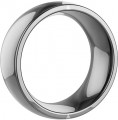Size
The size of the ring should correspond to the size of the finger on which it is intended to be worn. A product that is too large will dangle and even fall off, while a product that is too small will put too much pressure on your finger (if it fits on it at all).
There are several options for marking the size of smart rings. So, in the American style, it is customary to indicate size in numbers from “7” to “11” (smaller and larger values also occur, but quite rarely). A more traditional designation is the diameter of the ring, expressed in millimeters - it is customary to mark classic and jewelry rings in a similar way. In any case, there are special tables and measuring kits to determine the appropriate size.
Body material
Materials used for smart ring bodies:
–
Ceramic. Ceramic is made through sintering and firing at high temperatures. It is strong, durable, and extremely resistant to scratches and damage, maintaining its appearance for a long time. However, it is susceptible to damage from strong, localized impacts.
–
Steel. Steel is strong, reliable, and resistant to corrosion. It has a stylish look and is relatively affordable, cheaper than ceramic and titanium. However, it is heavier, and some users may experience allergies to the metal.
—
Titanium. A premium material that is both lightweight and extremely strong. Titanium rings hold their shape well under impact, are resistant to corrosion, and are hypoallergenic. On the downside, they are sensitive to scratches and are the most expensive option.
—
Metal. Cases made from various metal alloys combine high strength, durability, and resistance to external factors in one product. It should be noted that steel smart rings are not included in this category — they are listed separately (see "Steel" above).
Dustproof & waterproof
Level of dust and moisture protection according to the IP standard to which the gadget complies.
This parameter is usually indicated by the letters IP and two characters after them (for example,
IP56,
IP68). The numbers indicate a specific degree of protection: the first - from foreign objects and dust (maximum 6), the second - from water (maximum 8). The maximum degree of protection according to this standard is IP68, that is, complete tightness.
Instead of one of the numbers, the letter X may be indicated - this means that certification for this indicator has not been carried out: for example, an IPX7 device has a moisture resistance of 7, but has not been tested for dust protection. However, a high degree of protection against water automatically entails good dust resistance.

